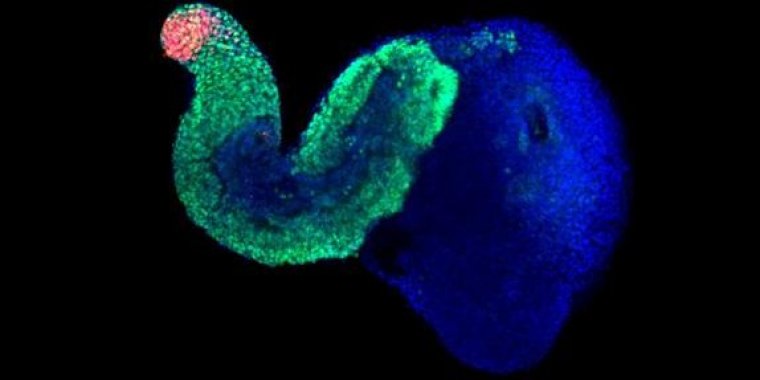| News / Science News |
Scientists develop mouse ‘embryo-like structures’ with organisation along body’s major axes
The definitive architecture of the mammalian body is established shortly after the embryo implants into the uterus. This body plan has spatial references, or axes, that guide the emergence of tissues and organs: an antero-posterior axis defined by the head at one end and the tail at the other, an orthogonal dorso-ventral axis and a medio-lateral axis, which orientates the arrangement of internal organs like the liver, pancreas or the heart.

Seven-day old gastruloid. Image credit: Mehmet Girgin, EPFL (CC BY 3.0)
Earlier findings from the Cambridge group had shown that embryonic stem cells could self-organise in culture into structures with an antero-posterior polarity.
Now, in collaboration with researchers from the University of Geneva and the Swiss Federal Institute of Technology Lausanne (EPFL), they have extended the cultures to reveal a capacity of mouse stem cells to produce ‘pseudo-embryos’ that display some of the important characteristics of a normal mouse embryo.
Established from only 300 embryonic stem cells, these structures, called ‘gastruloids’, exhibit developmental features and organisation comparable to the posterior part of a six to ten day-old embryo.
The study shows that gastruloids organise themselves with regard to the three main body axes, as they do in embryos, and follow similar patterns of gene expression.
One example of this is the pattern of expression of Hox genes, an ensemble of genes that are expressed in a precise sequential order in the embryo and act as landmarks for different aspects of the body, including the position of different vertebrae or of limbs.
This degree of organisation makes gastruloids a remarkable system for the study of the early stages of normal or abnormal embryonic development in mammals.
The researchers identified and quantified the RNA transcribed from gastruloids and compared the expressed genes with those of mouse embryos at comparable stages of development, which showed there was a high degree of similarity.
These embryo-like structures express genes characteristic of the various types of progenitor cells necessary for the constitution of future tissues.
The researchers say that these pseudo-embryos will allow an alternative method to animal research, in accordance with the principle of the ‘3Rs’ (the reduction, replacement and refinement of the use of animals in research).
The finding that so much of the development of an embryo can be recapitulated using stem cells will also increase researchers’ ability to study the genetic mechanisms underlying normal development and disease. (University of Cambridge)
YOU MAY ALSO LIKE



